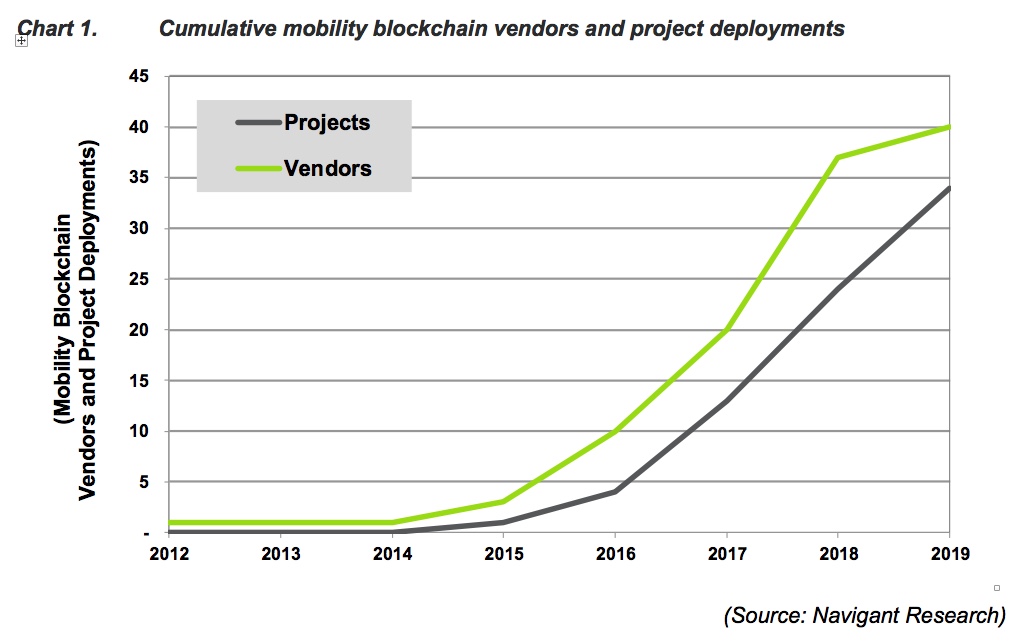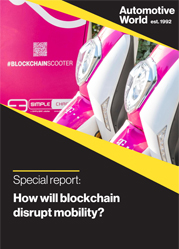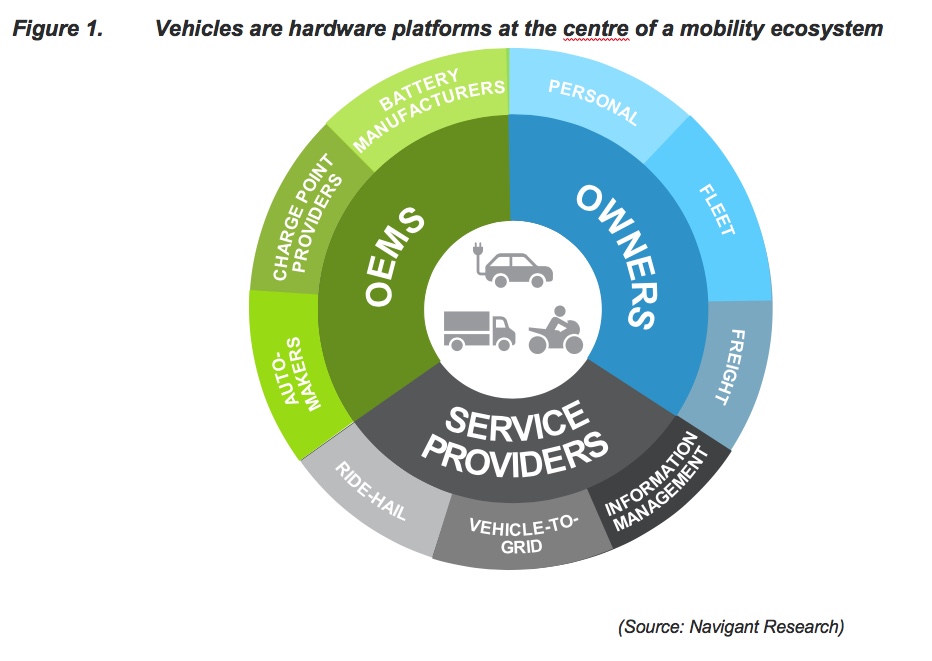Disruption is a difficult word. Clients are often advised by Navigant Research, a Guidehouse company, to take the long view and consider disruption as part of a larger transformation—a constant push to evolve and adapt to a changing energy and transportation landscape. Transformation involves many small disruptions, not all of which will be as sudden or clear-cut as Uber upending the traditional ride-hailing business model or Facebook taking over the media world.
Blockchain technology is just one inflection point of a mobility services transformation that has many drivers, among them widespread electrification, a proliferation of customer-facing services, and ubiquitous connectivity between vehicles, devices, and grid systems. Originally developed to support cryptocurrencies and financial services, blockchain has spread across a range of industries that stand to benefit from data authentication, automated business processes, and new business models.
Interest in blockchain technology has grown in the transportation sector. Chart 1 shows the growth in mobility blockchain project deployments between 2012 and 2019, and the number of blockchain vendors who focus on at least one mobility use case. Industry giants Daimler, Jaguar Land Rover, BMW, Honda, Ford, and many start-ups have launched blockchain pilots or partnerships.

This article surveys the role of blockchain technology in the transformation of mobility. It begins with a user-friendly description of blockchain, followed by an analysis of blockchain’s potential from three key perspectives: owners, service providers, and automakers. These three groups are the major players in an evolving ecosystem of mobility services.
Blockchain technology: a new way to manage networks
If vehicles are the hardware platform for mobility services, blockchain technology is a contender to become the software platform that makes those services possible. It can ensure the authenticity of underlying data and execute low friction automated payments and transactions.
Blockchain is an information technology that creates a single, trusted record of data for a network of devices. Crucially, blockchain networks are not owned and operated by a single company, but collectively by the entire network. The rules that govern interactions between network participants are based in code rather than in paper contracts and cannot be changed without the digital agreement of a majority of participants. Finally, every transaction between network participants (financial or otherwise) is recorded in a cryptographically linked, tamper-resistant ledger shared and replicated across many different devices. The cryptographic linkage ensures that any change to the shared ledger made by one device, whether malicious or benign, is immediately evident to the rest of the network.
Service providers capitalise on low friction transactions
Personal vehicles have undergone a transformation in the last several decades. In short, cars are becoming computers. Estimates vary, but the average car in 2018 contains somewhere between 100 and 200 million lines of software code. Many vehicles have a cellular network connection and are capable of hosting third-party software applications including personal assistants, navigation, and infotainment services. These capabilities enable service providers to maintain a persistent connection with their customers long after a vehicle leaves the lot.
Blockchain will shake-up the world of mobility service providers even further. Blockchain-based micropayments will enable service providers to create incentive programs and business models that attract customers and potentially undercut competitors that rely on traditional technologies. Imagine a rival to Uber that uses blockchain to pay its drivers every hour (or even in real time) rather than weekly, as Uber does now. The immediacy of the reward would fundamentally change the relationship of drivers to the gig economy, and for any other service that offers an incentive for participation—including smart charging and vehicle-to-grid (V2G) applications.
Vehicle owners are active participants in new business models
Owners of both personal and fleet vehicles benefit from the expanding scope of services offered by mobility service providers, often in the form of access to new revenue streams. For example, as the deployment of EVs accelerates, operators responsible for balancing grid systems will be increasingly involved in managing charging behaviours, potentially drawing on docked EVs as flexibility resources for the grid. To take full advantage of these opportunities, grid operators will need low friction incentive programs that reward participation.
V2G applications are not the only way to generate revenue from vehicles. Share&Charge, owned by Enel X, functions as an analogue of Airbnb for EV charging. Through the platform, EV owners can purchase the right to charge their vehicles at a private charging station at a price and time set by the owner. In the US, eMotorWerks and transactive energy pioneer LO3 Energy piloted a peer-to-peer model that enables EV owners to trade power with participants in a residential microgrid. In both cases, identity verification, trades, and payments are accomplished with blockchain and smart contracts.
Vehicle owners will also benefit from an increasingly streamlined and seamless customer experience. Blockchain creates a foundation for secure and auditable transactions between machines: in the future, individual vehicles will store digital value and use it to pay for charging, tolls, and parking with no need for human involvement. These advances will benefit traditional drivers and underpin management of automated fleets. Applications are already under development by companies like Filament, Car eWallet, and Daimler.
Automakers look to blockchain for supply chain transparency
Automotive and mobility OEMs will experience blockchain differently to either service providers or vehicle owners, though there is some overlap between the three groups. One of the early applications of blockchain technology is to increase visibility, transparency, and information management efficiency in supply chains.
Blockchain gives companies access to a comprehensive, tamper-resistant record of a product or material’s movement through the supply chain network. Information stored in this record can be shared on a need-to-know basis with other parties in the network, with customers, and even with competitors if necessary. In 2019, Volvo announced that it would use blockchain to improve the traceability of cobalt used in its vehicle batteries—a play intended to help meet customer demands for ethically sourced products.
Blockchain will not solve all of the challenges that automakers face in supply chain management—and it will create some new ones. Nevertheless, its impact will be substantial. IBM projects that updating supply chain processes to take advantage of blockchain will increase global GDP by 5% and trade volume by 15%.
Cross-cutting consortia drive blockchain forward
Blockchain holds great promise for mobility services. In some cases, it delivers value by improving the efficiency of existing business process, as in the supply chain. In others, it creates new opportunities for vehicle owners to generate value from their investments or for service providers to compete for customers.
There are many varieties of blockchain technology, and this article does not attempt to parse them all. There is no ‘one size fits all’ blockchain solution; any company looking to capitalise on the promise of blockchain must do its due diligence to determine whether blockchain is a good fit for its business needs and, if so, must determine which technology ecosystem is the right play. It is essential to recognise blockchain generates value that will be directly related to the size and activity of the networks in which it is deployed. For this reason, many of the most interesting and valuable applications of blockchain originate in industry consortia that bring together regulators, technology and service providers.
Several consortia have formed to develop standards and promote data sharing among mobility and transportation companies. Two of the largest are the Mobility Open Blockchain Initiative (MOBI) and the Blockchain in Transport Alliance, both of which count many of the largest automakers among their members. As transportation electrifies, cross-pollination between these groups and energy-focused consortia like the Energy Web Foundation will be essential to advance solutions and develop industry standards.
Blockchain’s ultimate purpose, which is often lost in the noise and excitement, is to make the provenance and authenticity of data provable. Doing so establishes a solid foundation for automated transactions, business processes, and full-featured applications that turn that data into value. It is these applications, rather than blockchain per se, that promise to transform mobility in the age of the Energy Cloud.
About the author: Johnathon de Villier is a Research Analyst at Navigant Research





